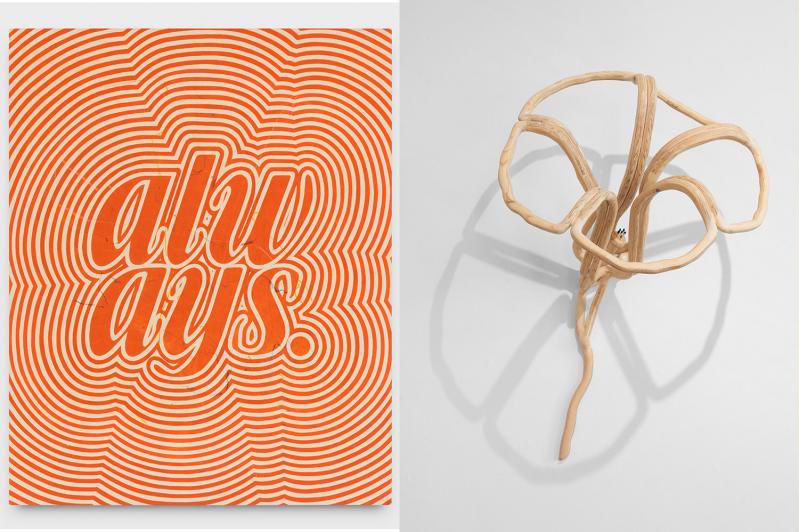Edsel Williams has an uncanny eye for artists at breakthrough moments or those about to emerge into the general consciousness. “Paradise,” his latest exhibition at the Fireplace Project in Springs, features Andrew Brischler and Lee Relvas, who are getting notice for their individual showings in galleries and art fairs, but who also seem as if they are on the precipice of something bigger.
Ms. Relvas’s bent plywood sculptures are both visually intriguing and captivating from the aspect of their manufacture. They’re a mixture of thin wood and putty, and the artist has told the web journal Lookie Lookie that she sands them to a degree that it is a “pervy process! They are so touched by me.” She said the sanding, which takes hours upon hours, is not only about the resulting surface appearance, but the feeling of them under her fingers.
In that interview, she was speaking about her figurative sculptures, of which there are two in the show. One, called “Holding,” is a half-figure cradling a crumpled sheet of loose-leaf paper. From that description, the work sounds basic, but it is anything but. The outlines, as executed in her bent wood, are gracefully balletic in their linearity. They only faintly describe the subject at hand, leaving much to be filled in by the imagination, while asserting strongly what it is. The paper that the figure grasps likely has some personal meaning, since the artist is also a writer in addition to being a performer and a singer.
“Hiding” is cocoon-like, with the same round, abstracted head she uses in this series and a body that is generalized and seemingly wrapped-up in appearance. It is a great emblem for this time of year on the South Fork, when the number of people and events can be overwhelming. That the figures are not gender specific is intentional. The artist sees them as queer in nature, to demonstrate how gender is a product of both society and self-definition.
The plant-like forms she offers in this show are also evocative. Typically floral, the majority, each called “Elegy,” have matches representing their stamens. The match heads have colors such as red, blue, and green, and each “Elegy” is named for the color of the match head. The peril implied by the materials — wood vulnerable to the matches’ potential fire — is taken to its conclusion in “Elegy (Black),” in which the matches
“Invasive Species” is slightly different. The plant’s branches sprout mouth-like buds formed of the pretty parts of real American currency. It pulsates with allegorical energy at the end of another rosé-soaked “Hamptons” summer.
Mr. Brischler, who showed his work last summer at a Sotheby’s event at Madoo Conservancy in Sagaponack, continues to offer text-driven works that stress form as much as function in their colored pencil-on-panel compositions.
Of his primary occupation since 2015, he told the online magazine Frontrunner that in 2015 “I started to put abstraction right up against appropriated text. That was something really interesting to me because it sort of grounded the text in this world of fine art; it butted the history of abstraction right up against this world of commercial design.”
Although he also makes completely abstract works, here he uses text as a form subject to manipulation and as its own source of abstraction. With wavy lines as in “Always (Red Throb)” or wavy text as in “Promises, Promises,” he varies his emphasis on themes and
Yet the text can’t help but get in the way, and sometimes it highlights the work of Ms. Relvas. “Secret Garden,” Mr. Brischler’s assemblage of graphically crisp sans-serif letters that bring their own shadows to the composition, complements the themes introduced by the floral sculptures, but also the shadows Ms. Relvas’s sculptures produce on the walls behind them.
The wavy and ghost-like text of “Promises, Promises” reminds us that vows can be ephemeral. “Always,” in its linear reverberations, provides its own half-life. “Shadows,” a work whose text is executed in drippy bright yellow freehand on a pitch-black ground, produces its own light. Paradise is a jumble, and so on. The obvious plays on meaning make you question their function, as they seem to distract from a deeper intention.
The tension between text as compositional element and signifier enlivens these works, forcing viewers to keep their wits about them, lest they make too much of one thing over another.
The show will remain on view through Sept. 15, and then the gallery closes for the winter.

